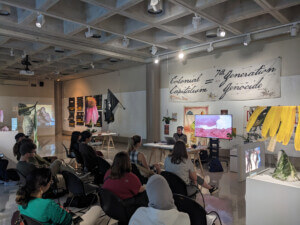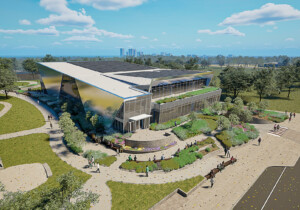“For I found the greatest difficulty for a Negro writer was the problem of revealing what he truly felt, rather than serving up what negroes were supposed to feel, and were encouraged to feel.” —Ralph Ellison, “On Becoming a Writer”
I have undergone a profound—and tragic—transformation. I am no longer a human being. I have become a phenomenon, a construct, an obsidian-toned orb. I am a check on a checklist, a bar on a graph, a bullet point in a presentation, whose most interesting characteristic is the reflectivity of light upon my dark bare skin.
In fact, in the wake of such a surplus of “diversity initiatives,” many of the recent efforts in architecture to include me have nudged me further into exclusion. If anything, tensions between my white colleagues and me have now materialized where they did not before exist, mostly from these colleagues’ newfound belief that they have personally wronged me in some way. Or their prophetic yearning to tell me how oppressed I am and how they understand that they are the cause of such oppression, even though I do not and never have viewed myself as oppressed.
Never before have I been so preached to as to the nature of my existence, as to how I am to understand who it is that I am. I previously had not encountered so many people who purport to so deeply understand the “Black experience.” I was not aware that there was any such singular experience. And if there is a universal reality that exists for all Black people, I fear I am the only one who has missed out on the revelation.
There seems now to be an inherent assumption held by others about what it is I experience and, even worse, about what it is that I believe and hold true, or—and here is the tragedy—what it is I should believe and hold true. I, and all Black Americans, have been lumped together and reduced—at least in principle—to a spiritless Black shadow. When we attach the notion of Blackness to an overarching ideological narrative, we rob Black people of their full humanity and their freedom to interact with the world on their own terms.
This is what James Baldwin meant when he wrote in his essay “Letter from a Region in My Mind” that liberals of his day “could deal with the Negro as a symbol or a victim but had no sense of him as a man.”
Black as a subcategory
“For me, the history of the place of Black people in this country is so varied, complex, and beautiful. And impactful.” ―Toni Morrison, from the documentary Toni Morrison: The Pieces I Am
Architecture’s Eurocentric emphasis is no secret. Often, adherence to the principles of the Bauhaus and related modern formalisms is presented as the only way to think about, learn about, and practice architecture. Our “canon” remains starkly Eurocentric, and while I would not personally deem this “racist,” I find it incomplete and astoundingly incomprehensive. Many acknowledge this lack today. But in our efforts to expand this canon, at times all things “Black” are hurled into a subcategory. Some say, “Here, let me teach you about architectural thought and history. These are all of the great buildings you should know about, and here and all the great architects. Oh, and here is all the Black stuff. We need to make sure we include them, too.”
No matter how one tries to spin it, it is impossible to escape the fact that labeling something as “Black” in this way automatically situates it as something “other,” something separate from what is considered “normal.” This rhetoric reinforces whiteness as the implicit standard or the default that everything else defers to.
I am not critiquing the important work by Black designers, artists, and architects who investigate the unique role of Blackness in aesthetic expression as it pertains to the built environment. My critique is aimed at the fashionable practice of perpetually situating Black practitioners into a separate category for no other reason than to partake in the latest form of virtue signaling. There are times to celebrate and acknowledge shared qualities among Black practitioners, but I hardly think it should be done ad infinitum without consideration.

Let’s celebrate, not segregate
“I prefer to be true to myself, even at the hazard of incurring the ridicule of others, rather than to be false, and to incur my own abhorrence.” ―Frederick Douglass, Narrative of the Life of Frederick Douglass
Not only have I been transformed into an idea, I have also been thrown into a subcategory against my will. My issue with many recent “antiracist” practices is the white liberal’s preoccupation with their adherence to inclusive behavior, which almost always contributes more to my exclusion than my inclusion. To include me would be to simply interact with me as a fellow human being, not as a Black “other” who must be carefully navigated, your every word cautiously considered lest I unravel like some untamed zoo animal incapable of exchanging ideas.
Black Americans are not a monolithic group. We are not all the same. We do not all think the same things, experience life in the same way, or come to the same conclusions. What should be celebrated in the Black community is the extraordinary range and beautiful diversity of our humanity.
In his essay “Blues People,” which, among other things, looks at Black Americans as the creators of mainstream American culture, Ralph Ellison writes, “What group of musicians has made more of the sound of the American experience? Nor am I confining my statement to the sound of the slave experience, but am saying that the most authoritative rendering of America in music is that of the American Negroes.” This contribution to universal culture is another argument for seeing and celebrating Blackness beyond the narrow confines of epidermal predicament and generational trauma.
Ellison emphasizes the fact that while Black Americans endured a special kind of cruelty historically, we have come to embrace and understand what it means to be American in such a deep and spiritual way as to be able to render it in one of the most visceral forms of aesthetic expression available to us—that of music. I argue that Black Americans have also done this—and will continue to do this—in other creative fields, including literature, painting, sculpture, and architecture.
I am excited about what our architectural renewal will look like and hope it will benefit not just Black architects and designers, but all architects and designers. In our ongoing discourse around Blackness, let us not ignore the past, but let us also not limit our focus to the ghost of slavery, as Ellison wrote. Let us celebrate the diversity of Black America, of a people who cannot be put into a box or reduced to an idea and who are free to chart their own course outside the attempted categories inscribed by others.
Sean Joyner is a writer and commentator who focuses on architecture, its role in society, and the social, psychological, and philosophical dynamics within the field.











